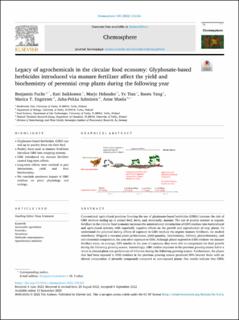| dc.contributor.author | Fuchs, Benjamin | |
| dc.contributor.author | Saikkonen, Kari | |
| dc.contributor.author | Helander, Marjo | |
| dc.contributor.author | Tian, Ye | |
| dc.contributor.author | Yang, Baoru | |
| dc.contributor.author | Engström, Marica T. | |
| dc.contributor.author | Salminen, Juha-Pekka | |
| dc.contributor.author | Muola, Anne | |
| dc.date.accessioned | 2022-10-24T16:53:20Z | |
| dc.date.available | 2022-10-24T16:53:20Z | |
| dc.date.created | 2022-10-06T11:02:59Z | |
| dc.date.issued | 2022-09-13 | |
| dc.identifier.citation | Chemosphere. 2022, 308 (2), . | en_US |
| dc.identifier.issn | 0045-6535 | |
| dc.identifier.uri | https://hdl.handle.net/11250/3028031 | |
| dc.description.abstract | Conventional agricultural practices favoring the use of glyphosate-based herbicides (GBHs) increase the risk of GBH residues ending up in animal feed, feces, and, eventually, manure. The use of poultry manure as organic fertilizer in the circular food economy increases the unintentional introduction of GBH residues into horticultural and agricultural systems, with reportedly negative effects on the growth and reproduction of crop plants. To understand the potential lasting effects of exposure to GBH residues via organic manure fertilizers, we studied strawberry (Fragaria x vescana) plant performance, yield quantity, biochemistry, folivory, phytochemistry, and soil elemental composition the year after exposure to GBH. Although plants exposed to GBH residues via manure fertilizer were, on average, 23% smaller in the year of exposure, they were able to compensate for their growth during the following growing season. Interestingly, GBH residue exposure in the previous growing season led to a trend in altered plant size preferences of folivores during the following growing season. Furthermore, the plants that had been exposed to GBH residues in the previous growing season produced 20% heavier fruits with an altered composition of phenolic compounds compared to non-exposed plants. Our results indicate that GBHs introduced via manure fertilizer following circular economy practices in one year can have effects on perennial crop plants in the following year, although GBH residues in soil have largely vanished. | en_US |
| dc.description.abstract | Legacy of agrochemicals in the circular food economy: Glyphosate-based herbicides introduced via manure fertilizer affect the yield and biochemistry of perennial crop plants during the following year | en_US |
| dc.language.iso | eng | en_US |
| dc.publisher | Elsevier Ltd. | en_US |
| dc.rights | Navngivelse 4.0 Internasjonal | * |
| dc.rights.uri | http://creativecommons.org/licenses/by/4.0/deed.no | * |
| dc.title | Legacy of agrochemicals in the circular food economy: Glyphosate-based herbicides introduced via manure fertilizer affect the yield and biochemistry of perennial crop plants during the following year | en_US |
| dc.title.alternative | Legacy of agrochemicals in the circular food economy: Glyphosate-based herbicides introduced via manure fertilizer affect the yield and biochemistry of perennial crop plants during the following year | en_US |
| dc.type | Peer reviewed | en_US |
| dc.type | Journal article | en_US |
| dc.description.version | publishedVersion | en_US |
| dc.rights.holder | © 2022 The Authors | en_US |
| dc.source.pagenumber | 10 | en_US |
| dc.source.volume | 308 | en_US |
| dc.source.journal | Chemosphere | en_US |
| dc.source.issue | 2 | en_US |
| dc.identifier.doi | 10.1016/j.chemosphere.2022.136366 | |
| dc.identifier.cristin | 2059071 | |
| dc.source.articlenumber | 136366 | en_US |
| cristin.ispublished | true | |
| cristin.fulltext | original | |
| cristin.qualitycode | 1 | |

